Identifying Suitable Zones for Tourism Activities on the Qinghai–Tibet Plateau Based on Trajectory Data and Machine Learning
Abstract
1. Introduction
2. Study Area and Data Source
2.1. Study Area
2.2. Data Sources and Processing
3. Methodology
3.1. Research Framework
3.2. Selection of Variables
3.2.1. Dependent Variable
3.2.2. Independent Variables
3.3. Geo-Detector
3.4. Model Building and Training
3.4.1. Principle and Applicability of Machine Learning
3.4.2. Implementation
- (1)
- Dataset Construction: Based on the number of trajectory points per grid, the dependent variable (Y) was classified into four levels using the quantile method: 0—Unsuitable Zone, 1—Low-Suitability Zone, 2—Medium-Suitability Zone, and 3—High-Suitability Zone [51]. These levels served as the classification labels for the models. The dataset was then randomly partitioned into a training set (80%) for model learning and a test set (20%) for performance evaluation.
- (2)
- Model Training and Evaluation: The model training and evaluation process was conducted within the Python 3.12 programming environment, primarily utilizing the scikit-learn library. To establish a standardized baseline for performance comparison, all six algorithms were trained using their default parameter settings. To identify the optimal algorithm, their performance on the unseen test set was rigorously evaluated using a comprehensive suite of metrics: Accuracy, Precision, Recall, F1 Score, Kappa Score, and the Area Under the Receiver Operating Characteristic Curve (AUC) [52].
- (3)
- Prediction and Mapping: The best-performing model from the evaluation phase was subsequently applied to the gridded dataset covering the entire QTP. The model predicted a suitability class for each grid cell, and the results were then visualized as a comprehensive tourism activity suitability map using ArcGIS 10.8.
4. Results
4.1. Analysis of Influencing Factors
4.2. Model Performance Evaluation
4.3. Analysis of Tourism Activity Suitability Zones
5. Discussion
5.1. Effectiveness and Superiority of the Research Method
5.2. The Primacy of Infrastructure over Resource Endowment
5.3. The Synergistic Coupling of Multiple Factors
5.4. The Resulting Spatial Pattern of Tourism Suitability
6. Conclusions
Author Contributions
Funding
Data Availability Statement
Acknowledgments
Conflicts of Interest
References
- Withanage, N.C.; Chanuwan Wijesinghe, D.; Mishra, P.K.; Abdelrahman, K.; Mishra, V.; Fnais, M.S. An ecotourism suitability index for a world heritage city using GIS-multi criteria decision analysis techniques. Heliyon 2024, 10, e31585. [Google Scholar] [CrossRef]
- Benabbou, A. Land use suitability analysis using an approach combining GIS, regionalization, and PROMETHEE II. Ann. GIS 2024, 30, 121–136. [Google Scholar] [CrossRef]
- Baltranaitė, E.; Inácio, M.; Valença Pinto, L.; Bogdziewicz, K.; Rocha, J.; Gomes, E.; Pereira, P. Tourism impacts on marine and coastal ecosystem services: A systematic review. Geogr. Sustain. 2025, 6, 100277. [Google Scholar] [CrossRef]
- Milano, C.; Koens, K.; Russo, A.P. The politics of urban tourism (im)mobilities: Critical perspectives on inequalities and social justice. Cities 2024, 152, 105148. [Google Scholar] [CrossRef]
- Paiva, D. The paradox of atmosphere: Tourism, heritage, and urban liveability. Ann. Tour. Res. 2023, 101, 103600. [Google Scholar] [CrossRef]
- Rogowski, M.; Zawilińska, B.; Hibner, J. Managing tourism pressure: Exploring tourist traffic patterns and seasonality in mountain national parks to alleviate overtourism effects. J. Environ. Manag. 2025, 373, 123430. [Google Scholar] [CrossRef] [PubMed]
- Wang, Z.; Li, J.; Liang, L. Ecological risk in the Tibetan Plateau and influencing urbanization factors. Environ. Chall. 2022, 6, 100445. [Google Scholar] [CrossRef]
- Yang, B.; Wu, J.; Miao, A.; Ran, J.; Jia, R. Balancing tourism development and habitat conservation in fragile ecosystems: A case study of the Qinghai-Tibet Plateau. PLoS ONE 2025, 20, e0327803. [Google Scholar] [CrossRef]
- Hua, Y.; Yong, X.U.; Kan, Z.; Lijia, W.; Lin, X.U. Evaluation of suitability, adaptability, and reserve potential of construction land on the Qinghai-Tibet Plateau. J. Geogr. Sci. 2024, 34, 41–61. [Google Scholar] [CrossRef]
- Luo, Y.; Yang, D.; O’Connor, P.; Wu, T.; Ma, W.; Xu, L.; Guo, R.; Lin, J. Dynamic characteristics and synergistic effects of ecosystem services under climate change scenarios on the Qinghai–Tibet Plateau. Sci. Rep. 2022, 12, 2540. [Google Scholar] [CrossRef]
- Li, W.; Liu, Y.; Lin, Q.; Wu, X.; Hao, J.; Zhou, Z.; Zhang, X. Identification of ecological security pattern in the Qinghai-Tibet Plateau. Ecol. Indic. 2025, 170, 113057. [Google Scholar] [CrossRef]
- Lu, T.; Li, C.; Zhou, W.; Liu, Y. Fuzzy Assessment of Ecological Security on the Qinghai-Tibet Plateau Based on Pressure-State-Response Framework. Remote Sens. 2023, 15, 1293. [Google Scholar] [CrossRef]
- Gigović, L.; Pamučar, D.; Lukić, D.; Marković, S. GIS-Fuzzy DEMATEL MCDA model for the evaluation of the sites for ecotourism development: A case study of “Dunavski ključ” region, Serbia. Land Use Policy 2016, 58, 348–365. [Google Scholar] [CrossRef]
- McLoughlin, E.; Hanrahan, J. Evidence-informed planning for tourism. J. Policy Res. Tour. Leis. Events 2023, 15, 1–17. [Google Scholar] [CrossRef]
- Zabihi, H.; Alizadeh, M.; Wolf, I.; Karami, M.; Ahmad, A.; Salamian, H. A GIS-based fuzzy-analytic hierarchy process (F-AHP) for ecotourism suitability decision making: A case study of Babol in Iran. Tour. Manag. Perspect. 2020, 36, 100726. [Google Scholar] [CrossRef]
- Ronizi, S.R.A.; Mokarram, M.; Negahban, S. Utilizing multi-criteria decision to determine the best location for the ecotourism in the east and central of Fars province, Iran. Land Use Policy 2020, 99, 105095. [Google Scholar] [CrossRef]
- Raha, S.; Mondal, M.; Gayen, S. Ecotourism Potential Zone Mapping by Using Analytic Hierarchy Process (AHP) and Weighted Linear Algorithm: A Study on West Bengal, India. J. Geogr. Stud. 2021, 5, 44–64. [Google Scholar] [CrossRef]
- Núñez, J.C.S.; Gómez-Pulido, J.A.; Ramírez, R.R. Machine learning applied to tourism: A systematic review. WIREs Data Min. Knowl. Discov. 2024, 14, e1549. [Google Scholar] [CrossRef]
- Teixeira, J.P.; Fernandes, P.O. Tourism time series forecast with artificial neural networks. Tékhne 2014, 12, 26–36. [Google Scholar] [CrossRef]
- Dimitriadou, A.; Gogas, P.; Papadimitriou, T. Tourism and uncertainty: A machine learning approach. Curr. Issues Tour. 2025, 28, 2278–2298. [Google Scholar] [CrossRef]
- Habib, M.H.R.; Rahman, M.; Uddin, M.M.; Shimu, N.J.; Hasan, M.; Alam, M.J.; Islam, M.S. Application of AHP and geospatial technologies to assess ecotourism suitability: A case study of Saint Martin’s Island in Bangladesh. Reg. Stud. Mar. Sci. 2024, 70, 103357. [Google Scholar] [CrossRef]
- Sarkar, A.; Mondal, M.; Sarma, U.S.; Podder, S.; Gayen, S.K. Tourism Suitability Assessment in Malbazar Block using principal component analysis and analytical hierarchy process. Environ. Dev. Sustain. 2024. [Google Scholar] [CrossRef]
- Liu, J.; Xin, Z.; Huang, Y.; Yu, J. Climate suitability assessment on the Qinghai-Tibet Plateau. Sci. Total Environ. 2022, 816, 151653. [Google Scholar] [CrossRef]
- Mou, N.; Liu, Z.; Zheng, Y.; Makkonen, T.; Yang, T.; Zhang, L. Cycling in Tibet: An analysis of tourists’ spatiotemporal behavior and infrastructure. Tour. Manag. 2022, 88, 104418. [Google Scholar] [CrossRef]
- Wangjie, G.; Lou, Y.; Song, K.; Li, X.; Fang, Y.; Hou, J.; Sun, Y. Human-wildlife coexistence on the Qinghai-Tibet Plateau: The correlation between Tibetan Buddhist monasteries and avian community composition. People Nat. 2024, 6, 573–585. [Google Scholar] [CrossRef]
- Shao, D.; Zoh, K.; Xie, Y.Z. The spatial differentiation mechanism of intangible cultural heritage and its integration with tourism development based on explainable machine learning and coupled coordination models: A case study of the Jiang-Zhe-Hu in China. Herit. Sci. 2024, 12, 414. [Google Scholar] [CrossRef]
- Yuvaraj, R.M.; Ambrisha, S.; Muthunagai, S. Integrated AHP-TOPSIS models to evaluate suitability and sustainable development of beach tourism: A case in Chennai City, Tamil Nadu, India. J. Coast. Conserv. 2024, 28, 32. [Google Scholar] [CrossRef]
- Yu, H.; Chen, Q.J.; Hu, X.Y. Tourist interest areas and spatial movement patterns on the qinghai-Tibet plateau based on dynamic trajectory similarity. Habitat Int. 2025, 163, 103500. [Google Scholar] [CrossRef]
- Huang, S.; Yi, J.W.; Du, Y.Y.; Liang, F.Y.; Xu, R.; Wang, N.; Qian, J.L.; Tu, W.N.; Luo, P.X.; Xing, A.Z.F. Unveiling the potential supply of cultural ecosystem services on the Qinghai-Tibet Plateau: Insights from tourist hiking trajectories. Ecosyst. Serv. 2025, 73, 101711. [Google Scholar] [CrossRef]
- Zhang, H.; Dong, G.; Wang, J.; Zhang, T.-L.; Meng, X.; Yang, D.; Liu, Y.; Lu, B. Understanding and extending the geographical detector model under a linear regression framework. Int. J. Geogr. Inf. Sci. 2023, 37, 2437–2453. [Google Scholar] [CrossRef]
- Guo, Y.; Wu, Z.; Zheng, Z.; Li, X. An optimal multivariate-stratification geographical detector model for revealing the impact of multi-factor combinations on the dependent variable. GISci. Remote Sens. 2024, 61, 2422941. [Google Scholar] [CrossRef]
- Bollenbach, J.; Rebholz, D.; Keller, R. The road not taken: Representing expert knowledge for route similarities in sustainable tourism using machine learning. Electron. Mark. 2025, 35, 72. [Google Scholar] [CrossRef]
- Yao, T.; Thompson, L.G.; Mosbrugger, V.; Zhang, F.; Ma, Y.; Luo, T.; Xu, B.; Yang, X.; Joswiak, D.R.; Wang, W.; et al. Third Pole Environment (TPE). Environ. Dev. 2012, 3, 52–64. [Google Scholar] [CrossRef]
- Lu, Y.; Han, F.; Liu, Q.; Wang, Z.; Wang, T.; Yang, Z. Evaluation of Potential for Nature-Based Recreation in the Qinghai-Tibet Plateau: A Spatial-Temporal Perspective. Int. J. Environ. Res. Public Health 2022, 19, 5753. [Google Scholar] [CrossRef]
- Chen, X.; Wang, T.; Zheng, X.; Han, F.; Yang, Z. The Structure and Evolution of the Tourism Economic Network of the Tibetan Plateau and Its Driving Factors. Land 2022, 11, 241. [Google Scholar] [CrossRef]
- Huang, S.; Sheng, D.; Wang, P.; Xiao, J.; Li, Q.; Liu, H. Assessment of ecotourism suitability in Qilian mountain National park. Sci. Rep. 2025, 15, 19529. [Google Scholar] [CrossRef]
- Yue, Y.; Lan, T.; Yeh, A.G.O.; Li, Q.-Q. Zooming into individuals to understand the collective: A review of trajectory-based travel behaviour studies. Travel Behav. Soc. 2014, 1, 69–78. [Google Scholar] [CrossRef]
- Huang, W.; Wang, L. Towards big data behavioral analysis: Rethinking GPS trajectory mining approaches from geographic, semantic, and quantitative perspectives. Archit. Intell. 2022, 1, 7. [Google Scholar] [CrossRef]
- Mashkov, R.; Shoval, N. Using high-resolution GPS data to create a tourism Intensity-Density Index. Tour. Geogr. 2023, 25, 1657–1678. [Google Scholar] [CrossRef]
- Schmücker, D.; Reif, J. Measuring tourism with big data? Empirical insights from comparing passive GPS data and passive mobile data. Ann. Tour. Res. Empir. Insights 2022, 3, 100061. [Google Scholar] [CrossRef]
- Beeco, J.A.; Hallo, J.C.; Brownlee, M.T.J. GPS Visitor Tracking and Recreation Suitability Mapping: Tools for understanding and managing visitor use. Landsc. Urban Plan. 2014, 127, 136–145. [Google Scholar] [CrossRef]
- Wang, J.-F.; Zhang, T.-L.; Fu, B.-J. A measure of spatial stratified heterogeneity. Ecol. Indic. 2016, 67, 250–256. [Google Scholar] [CrossRef]
- Ma, X.; Yang, Z.; Zheng, J. Analysis of spatial patterns and driving factors of provincial tourism demand in China. Sci. Rep. 2022, 12, 2260. [Google Scholar] [CrossRef]
- Song, Y.; Wang, J.; Ge, Y.; Xu, C. An optimal parameters-based geographical detector model enhances geographic characteristics of explanatory variables for spatial heterogeneity analysis: Cases with different types of spatial data. GISci. Remote Sens. 2020, 57, 593–610. [Google Scholar] [CrossRef]
- Chen, J.; Wang, S.; Han, Y.; Zhang, Y.; Li, Y.; Zhang, B.; Li, X.; Zhang, J. Geodetector analysis of individual and joint impacts of natural and human factors on maternal and child health at the provincial scale. Sci. Rep. 2024, 14, 1643. [Google Scholar] [CrossRef]
- Lv, W.; Lei, Y.; Liu, F.; Yan, J.; Song, Y.; Zhao, W. gdverse: An R Package for Spatial Stratified Heterogeneity Family. Trans. GIS 2025, 29, e70032. [Google Scholar] [CrossRef]
- Pouwels, R.; van Eupen, M.; Walvoort, D.J.J.; Jochem, R. Using GPS tracking to understand the impact of management interventions on visitor densities and bird populations. Appl. Geogr. 2020, 116, 102154. [Google Scholar] [CrossRef]
- Sothe, C.; De Almeida, C.M.; Schimalski, M.B.; La Rosa, L.E.C.; Castro, J.D.B.; Feitosa, R.Q.; Dalponte, M.; Lima, C.L.; Liesenberg, V.; Miyoshi, G.T.; et al. Comparative performance of convolutional neural network, weighted and conventional support vector machine and random forest for classifying tree species using hyperspectral and photogrammetric data. GISci. Remote Sens. 2020, 57, 369–394. [Google Scholar] [CrossRef]
- Li, A.; Zhang, Z.; Hong, Z.; Liu, L.; Liu, Y. Evaluation method for ecology-agriculture-urban spaces based on deep learning. Sci. Rep. 2024, 14, 11353. [Google Scholar] [CrossRef] [PubMed]
- Zhang, G.; Li, X.; Zhang, L.; Wei, X. Dynamics and causes of cropland Non-Agriculturalization in typical regions of China: An explanation Based on interpretable Machine learning. Ecol. Indic. 2024, 166, 112348. [Google Scholar] [CrossRef]
- Berrettini, M.; Hennig, C.M.; Viroli, C. The quantile-based classifier with variable-wise parameters. Can. J. Stat. 2025, 53, e11837. [Google Scholar] [CrossRef]
- Sheth, V.; Tripathi, U.; Sharma, A. A Comparative Analysis of Machine Learning Algorithms for Classification Purpose. Procedia Comput. Sci. 2022, 215, 422–431. [Google Scholar] [CrossRef]
- Noll, B.; Filatova, T.; Need, A.; de Vries, P. Uncertainty in individual risk judgments associates with vulnerability and curtailed climate adaptation. J. Environ. Manag. 2023, 325, 116462. [Google Scholar] [CrossRef] [PubMed]
- Sánchez-Rivero, M.; Miguel-Barrado, V.; Rodríguez-Rangel, M.C.; Pérez-Calderón, E. Evolution of transport, accessibility and tourism competitiveness in Extremadura (Spain): A benchmarking analysis. Eur. Transp. Res. Rev. 2024, 16, 66. [Google Scholar] [CrossRef]
- Zhu, G.-r.; Wang, M.; Li, Q.-l.; Liu, J.; Zhao, Y.-n.; Gao, J.-w.; Xu, H.-l. Land development suitability analysis for transport planning evaluation and optimization in mountainous ecological region. J. Mt. Sci. 2022, 19, 862–873. [Google Scholar] [CrossRef]
- Ibanescu, B.-C.; Eva, M.; Gheorghiu, A.; Iatu, C. Tourism-Induced Resilience of Rural Destinations in Relation to Spatial Accessibility. Appl. Spat. Anal. Policy 2023, 16, 1237–1254. [Google Scholar] [CrossRef]
- Waleghwa, B.; Ioannides, D. “Everyone Wants to Drive There”: Challenges to Transport Sustainability in Rural Tourism Destinations. Int. J. Tour. Res. 2024, 26, e2810. [Google Scholar] [CrossRef]
- Cattaneo, A.; Adukia, A.; Brown, D.L.; Christiaensen, L.; Evans, D.K.; Haakenstad, A.; McMenomy, T.; Partridge, M.; Vaz, S.; Weiss, D.J. Economic and social development along the urban–rural continuum: New opportunities to inform policy. World Dev. 2022, 157, 105941. [Google Scholar] [CrossRef]
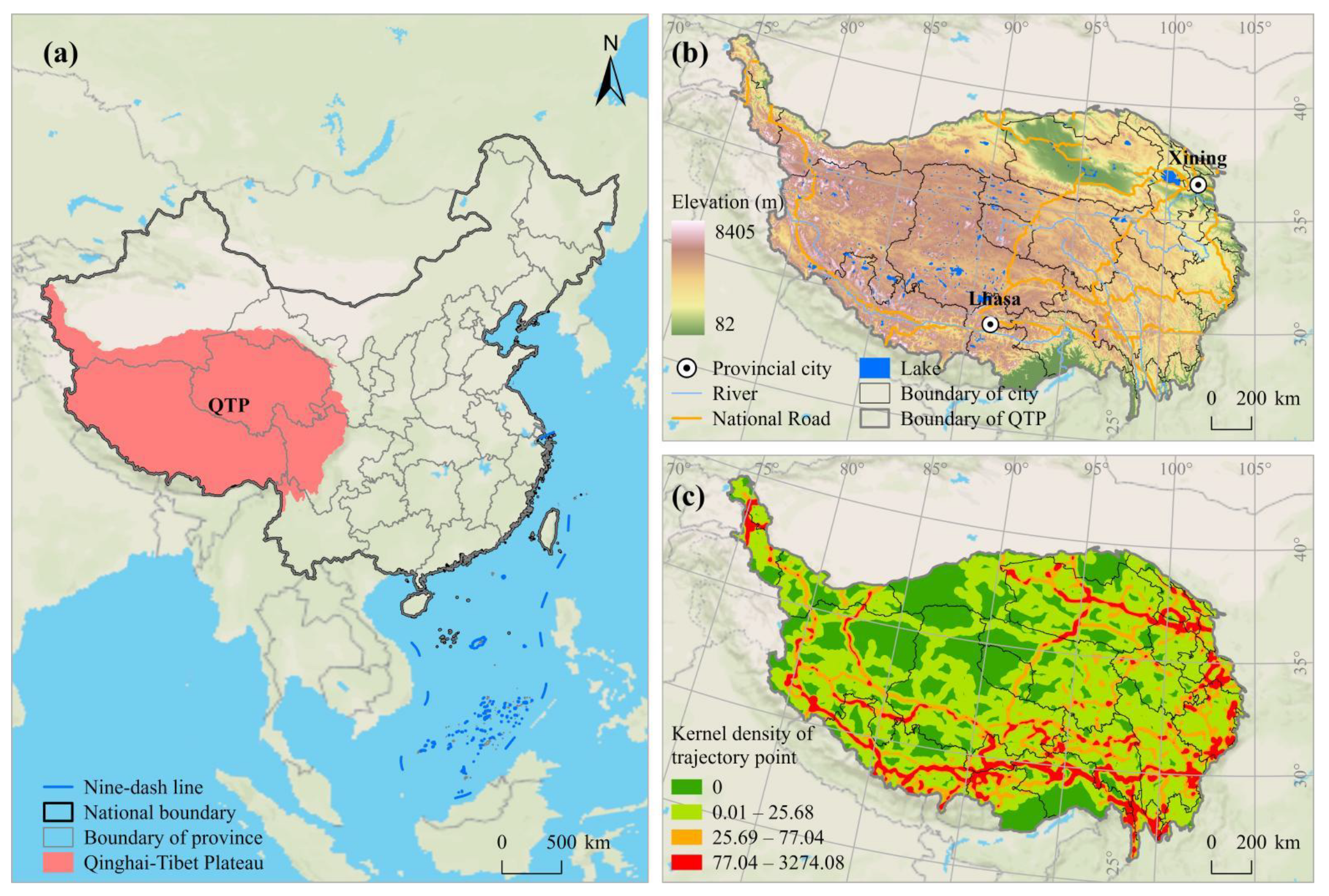
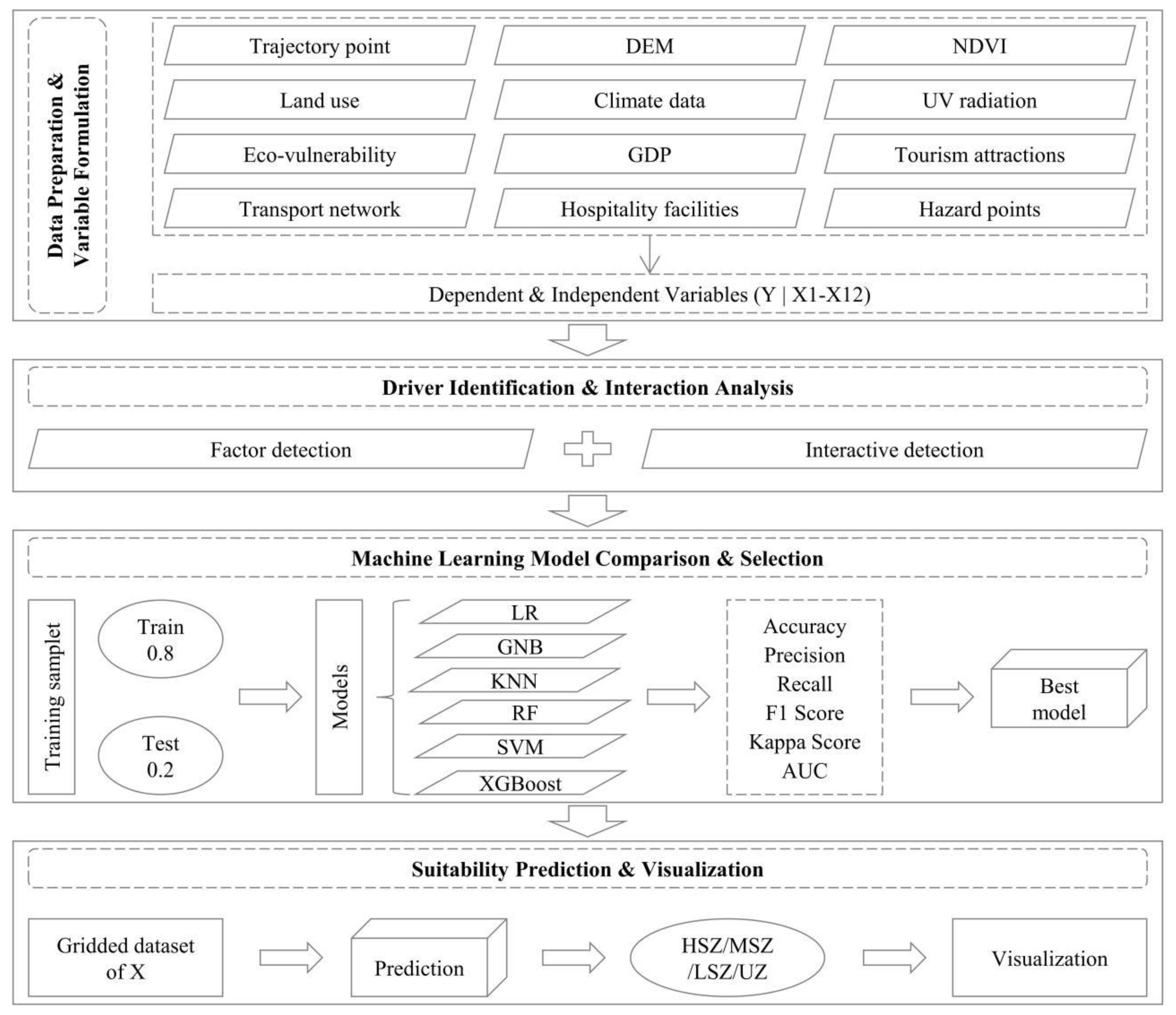
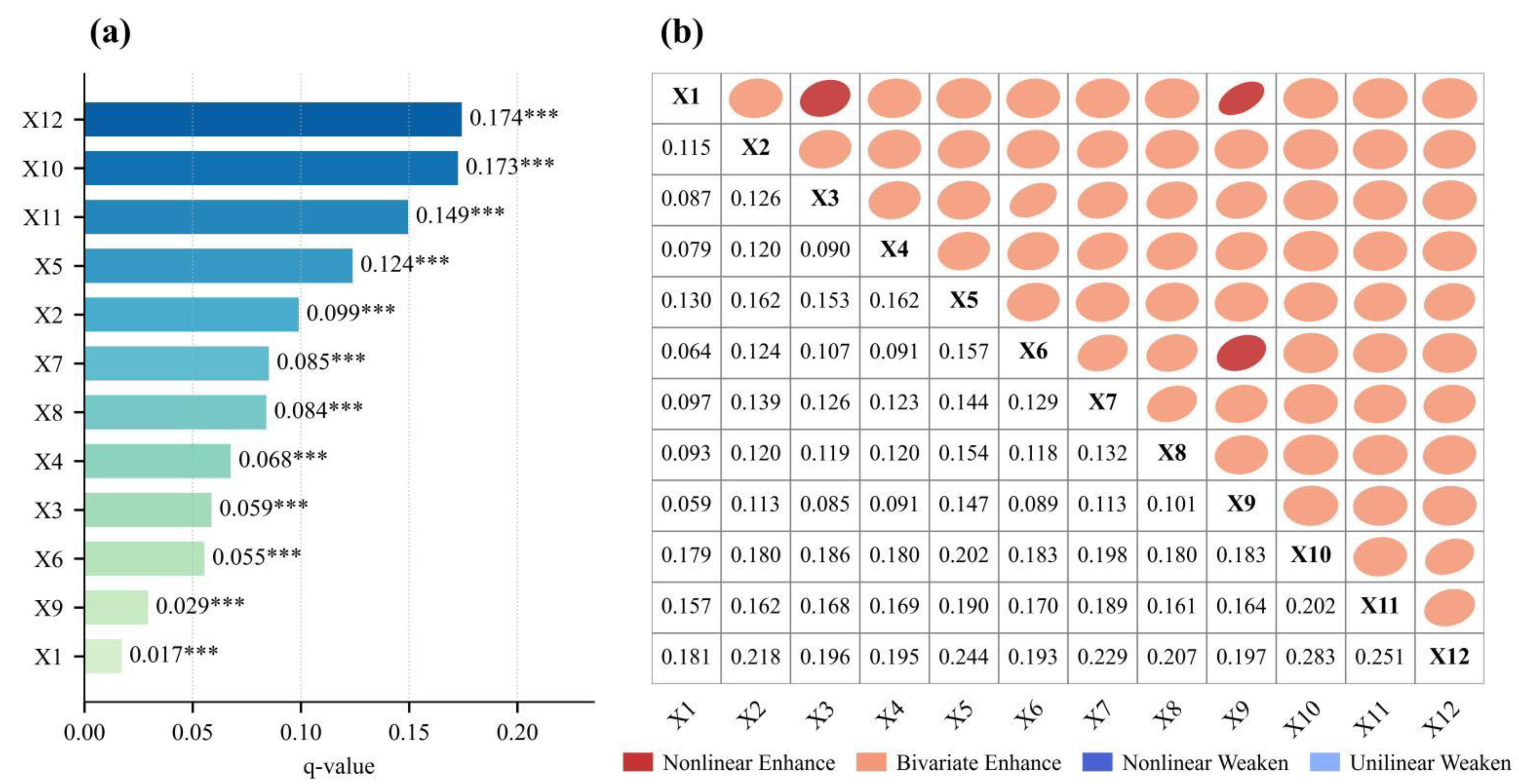

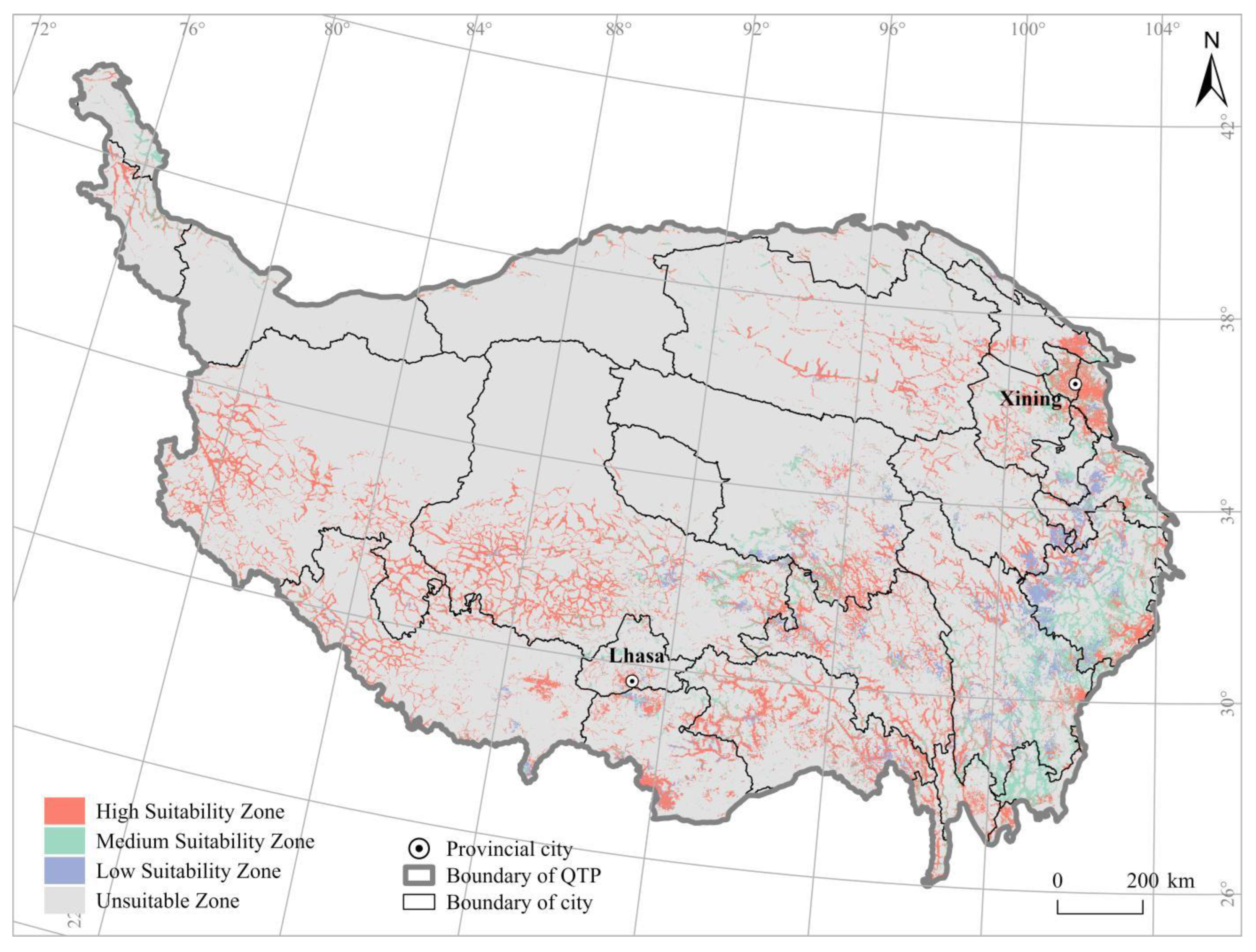

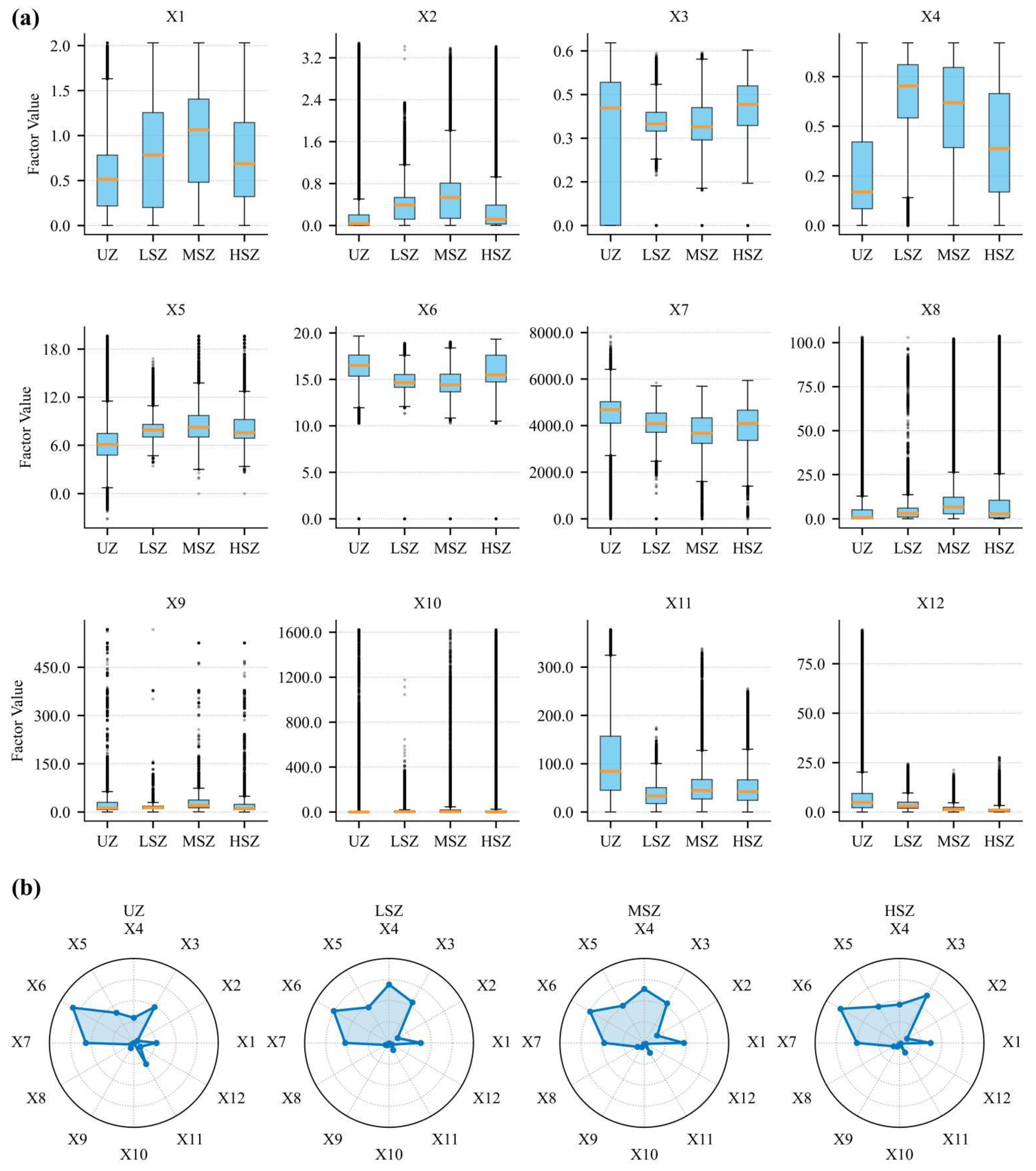
| Data Type | Description | Format | Temporal Coverage | Source |
|---|---|---|---|---|
| Trajectory point | High-precision GPS points representing tourist activity intensity. | Vector (point) | April 2023–December 2024 | https://www.foooooot.com/, accessed on 15 January 2025 |
| DEM | Digital Elevation Mode for calculating altitude. | 1 km Raster | 2020 | Resources and Environmental Science Data Center (https://www.resdc.cn/, accessed on 20 December 2024) |
| NDVI | Normalized Difference Vegetation Index. | 1 km Raster | 2023 | |
| Land Use | Classification of land cover types. | 1 km Raster | 2020 | |
| Climate Data | Annual mean temperature, precipitation, wind speed. | Station records | 2015–2023 | National Meteorological Science Data Center (http://data.cma.cn/, accessed on 25 December 2024) |
| UV Radiation | Annual mean ultraviolet radiation intensity. | Station records | 2015–2023 | |
| Ecological Vulnerability | Index assessing the sensitivity of the ecosystem. | 1 km Raster | 2020 | National Earth System Science Data Center (https://www.geodata.cn/, accessed on 25 December 2024) |
| Administrative Boundaries | Vector boundaries of the Qinghai–Tibet Plateau. | Vector (polygon) | 2020 | |
| GDP | Gross Domestic Product at the county level. | CSV | 2023 | Local Government Reports |
| Tourism Attractions | Official list of national A-level scenic spots. | Vector (point) | 2023 | Ministry of Culture and Tourism of PRC (https://www.mct.gov.cn/, accessed on 10 December 2024) |
| Transport Network | Major road network, including national and provincial highways. | Vector (point) | 2023 | OpenStreetMap (http://www.openstreetmap.org/, accessed on 15 December 2024) |
| Hospitality Facilities | Points of Interest, including hotels, restaurants, gas stations. | Vector (point) | 2023 | Amap (https://ditu.amap.com/, accessed on 10 December 2024) |
| Hazard Points | Location of historical natural disasters. | Vector (point) | 2015–2023 | Global Disaster Data Platform (https://www.gddat.cn/, accessed on 15 December 2024) |
| Dimension | Indicator | Code | Unit | Effect on Suitability | Description |
|---|---|---|---|---|---|
| Tourism Resource Endowment | Landscape Diversity Index | X1 | — | Positive | Measures landscape attractiveness using Shannon’s Diversity Index (SHDI) based on land use data. Higher values indicate greater attraction. |
| Scenic Spot Density | X2 | Positive | Measures tourism resource endowment via the Kernel density of A-level scenic spots. Higher values indicate richer resources. | ||
| Natural Geographical Environment | Ecological Vulnerability Index | X3 | — | Negative | Reflects the degree of ecological vulnerability. Higher vulnerability suggests the area is less suitable for tourism development. |
| Vegetation Coverage Index | X4 | — | Positive | Represents the condition of the ecological environment, derived from NDVI. Better environments have a stronger attraction for tourists. | |
| Temperature-Humidity Index | X5 | — | Positive | Indicates the level of climate comfort. More comfortable climates are more conducive to tourism. | |
| UV Radiation | X6 | W/m2 | Negative | Represents the intensity of ultraviolet radiation. Higher radiation levels can cause discomfort and are less suitable for tourists. | |
| Altitude | X7 | m | Negative | Indicates the probability of tourists experiencing altitude sickness. Higher values represent a greater likelihood of adverse reactions. | |
| Hazard Point Density | X8 | count/km2 | Negative | Reflects the safety level of the area via the Kernel Density of historical natural disasters. A higher value indicates lower safety. | |
| Supporting and Guaranteeing Conditions | GDP | X9 | 108 CNY | Positive | Measures the regional socioeconomic level. Higher GDP is associated with better supporting infrastructure and services. |
| Hospitality Facility Density | X10 | count/km2 | Positive | Measures tourism service capacity via the Kernel Density of hospitality facilities (e.g., hotels, restaurants). | |
| Distance to Urban Centers | X11 | km | Negative | Measures remoteness. Closer proximity to urban centers facilitates easier access to services for tourists. | |
| Distance to Main Roads | X12 | km | Negative | Measures accessibility. Closer proximity to main roads (national and provincial highways) facilitates easier tourist entry. |
| Factor | ||||||||||||
|---|---|---|---|---|---|---|---|---|---|---|---|---|
| X1 | X2 | X3 | X4 | X5 | X6 | X7 | X8 | X9 | X10 | X11 | X12 | |
| VIF | 0.299 | 0.162 | 1.052 | 0.398 | 0.113 | 0.009 | 0.039 | 0.774 | 0.811 | 0.983 | 0.401 | 0.657 |
| Suitability Zone | Area (km2) | Percentage (%) |
|---|---|---|
| High-Suitability Zone (HSZ) | 232,508 | 9.00 |
| Medium-Suitability Zone (MSZ) | 100,435 | 3.89 |
| Low-Suitability Zone (LSZ) | 48,256 | 1.87 |
| Unsuitable Zone (UZ) | 2,203,200 | 85.25 |
Disclaimer/Publisher’s Note: The statements, opinions and data contained in all publications are solely those of the individual author(s) and contributor(s) and not of MDPI and/or the editor(s). MDPI and/or the editor(s) disclaim responsibility for any injury to people or property resulting from any ideas, methods, instructions or products referred to in the content. |
© 2025 by the authors. Licensee MDPI, Basel, Switzerland. This article is an open access article distributed under the terms and conditions of the Creative Commons Attribution (CC BY) license (https://creativecommons.org/licenses/by/4.0/).
Share and Cite
Li, Z.; Xi, J.; Ye, S. Identifying Suitable Zones for Tourism Activities on the Qinghai–Tibet Plateau Based on Trajectory Data and Machine Learning. Land 2025, 14, 1885. https://doi.org/10.3390/land14091885
Li Z, Xi J, Ye S. Identifying Suitable Zones for Tourism Activities on the Qinghai–Tibet Plateau Based on Trajectory Data and Machine Learning. Land. 2025; 14(9):1885. https://doi.org/10.3390/land14091885
Chicago/Turabian StyleLi, Ziqiang, Jianchao Xi, and Sui Ye. 2025. "Identifying Suitable Zones for Tourism Activities on the Qinghai–Tibet Plateau Based on Trajectory Data and Machine Learning" Land 14, no. 9: 1885. https://doi.org/10.3390/land14091885
APA StyleLi, Z., Xi, J., & Ye, S. (2025). Identifying Suitable Zones for Tourism Activities on the Qinghai–Tibet Plateau Based on Trajectory Data and Machine Learning. Land, 14(9), 1885. https://doi.org/10.3390/land14091885





